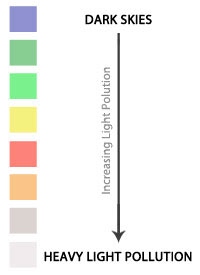Why are dark skies so important? Why travel 2-3 hours to a dark-sky site to see the night sky and learn about astronomy? Can’t I see stars and learn about astronomy in my own backyard? Yes, you can and you should! You can learn about astronomy and identify some stars and planets right in your own back yard. But a dark sky opens up a whole new viewing experience.
On a typical night in the city, one can see perhaps 200 stars. At a dark-sky site, one can see 2,000-3,000 stars. And that does not include the Milky Way, the cloud-like band of stars that forms part of our Milky Way galaxy and stretches across the sky. About 85% of people on the earth today have never seen the Milky Way.
Why? Light pollution. They do not have skies dark enough to see that magnificent band of stars. But it is easily visible at the Lone Star Observatory site. Moreover, with a telescope at a dark-sky site, the number of stars, nebulae, planetary nebulae, open star clusters, globular clusters, and galaxies that you can see is staggering and awe-inspiring. It’s worth the trip! Here is a link to the many types of objects you can see at Lone Star Observatory. Deep sky watch
The NASA Dark Skies map below shows the relative darkness of the skies above the observatory. The bright white spot on the bottom left is Plano, TX, and the whiteness just gets brighter as you move south.

Lone Star Observatory is located under Dark Skies!

Star-forming Nebulae

Omega or Swan Nebula

Trifid Nebula
Clouds of gas and dust found in our Milky Way galaxy in which new stars are being born.
